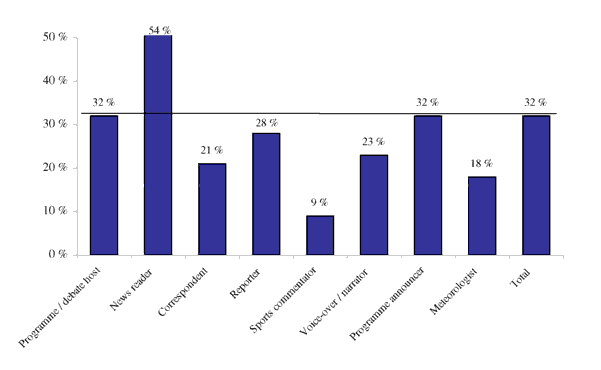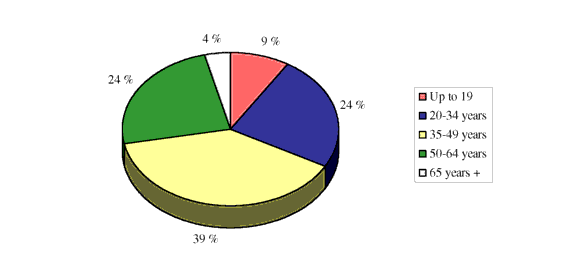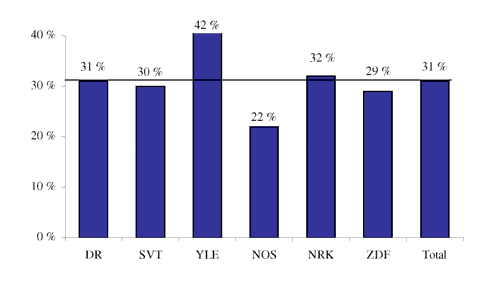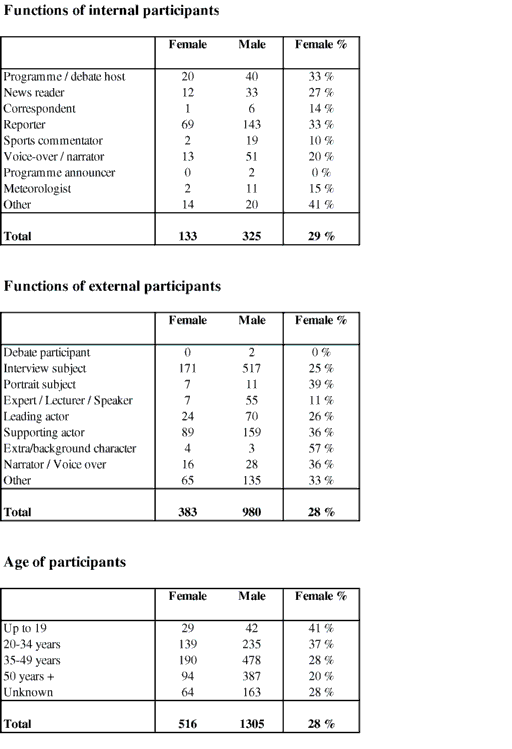Screening Gender
Who speaks in television?
A comparative study of female participation in television programmes

The project ”Screening Gender“ (1997–2000) was co-financed by the Equal Opportunities Unit of the European Commission (DGV) and by the following broadcasters: YLE (Finland), NOS (Netherlands), NRK (Norway), SVT (Sweden), ZDF (Germany) and DR (Denmark – first year only).
Contents
- Introduction
- The results: Who Speaks in Television?
- Overall participation
- Programme genres
- Programme topics
- Internal and external participants
- Programme functions of internal participants
- Functions and roles of external participants
- How the participants were introduced
- Age groups
- Duration of speech
- Tables for each country
- Denmark
- Sweden
- Finland
- The Netherlands
- Norway
- Germany
- Notes on the data collection
- The amount of data
- Quality control
- The questions
- Practical arrangements
- The Coding Schedule
Who speaks in television?
Introduction
This survey is part of the project ”Screening Gender“ (1997–2000). The project was developed by SVT (Sweden), YLE (Finland), NOS (Netherlands), NRK (Norway) and ZDF (Germany); DR (Denmark) also took part in the first year.
European public service broadcasters are mandated to reflect society, in all its aspects, through their programmes. They are also expected to play a role in informing and educating the public – that is, to be active in supporting democratic values and goals.
Women‘s participation in the media, and especially in television, has been the subject of debate throughout most of Europe for at least 25 years. The early focus, in the sixties and seventies, was on equal opportunities. But more recently the discussion has moved on to consider stereotypes and how to avoid them, how to show diversity and – in the end – how to create better television programmes. This is the focus of ’Screening Gender‘.
These days there tends to be a belief that gender representation in the media no longer needs much attention. The argument is frequently made that ’things have changed‘ and that the participation of women and men is now relatively equal.
How well-founded are these beliefs? This is what ’Who speaks in television?‘ aimed to find out, through an up-to-date, comparative piece of research.
In the study we wanted to measure:
- the number of men and women participating as speakers
- the duration of their speech
The analysis took into account:
- programme genres and topics
- internal vs. external participants
- functions and roles of the participants
- formal vs. informal introduction of participants
- age of participants
We analysed programmes during a ’constructed‘ week – seven days spread out over a period of three weeks in 1997–98. This artificial week meant that we could avoid undue influence from any major event that might occur within a ’real‘ week. We focused on prime time transmissions, and on in-house productions. The research framework was provided by NRK (Norway), which has been using the ’Who Speaks?‘ method to analyse its output since 1973. Each participating company was responsible for its own data collection. Analysis of the data was co-ordinated by NRK.
A printed version of the coding schedule is included at the end of this report. The computer software can be obtained from NRK.
Birgit Eie, Oslo 1998
The results: Who Speaks in Television?
Overall participation
Across these six countries, overall female participation in television programmes is 32%. Participation rates range from 28% in Denmark to 36% in Finland and Sweden:
Percentage of women participating in television programmes

Programme genres
Female participation in different programme genres*

* A few genres are excluded for certain broadcasters, because no programmes in that genres were coded during the survey period.
The number of programmes in each genre differed greatly, and the percentages for genres with relatively few programmes – for example, religious programmes and documentaries – must be treated with some caution.
There is a consistent pattern in relation to women‘s ’worst‘ and ’best‘ levels of representation in the various genres. In all countries female participation is lowest in sports programmes. It is most balanced in children‘s and youth programmes.

Programme topics
Does the topic of the programme make a difference to the level of female participation?
Women‘s participation in programmes according to topic

Again we see a very traditional division, with most female participation in programmes with topics such as human relations, family, health and social issues.
Internal and external participants
The study distinguished between ’internal‘ and ’external‘ participants. Internal participants are television employees or people who represent the television company on-screen – for example programme hosts, news readers, programme announcers. External participants are people from outside the company who take part in programmes – for example interviewees, politicians, actors, experts.
Female percentages of internal and external participants:


Overall, women participate equally in internal and external capacities. However there are some differences between countries.
For Finland and Norway women‘s representation is noticeably higher among internal participants than among external guests and experts.
For the Netherlands and Germany the picture is the opposite: here women are more likely to be found among people invited from outside the companies.
Programme functions of internal participants
Looking more specifically at the functions of the internal participants within programmes, one category stands out as being heavily associated with women – the category of newsreader.
Female participation in various internal programme functions

Although women are only 32% of all internal participants in the programmes, 54% of television newsreaders are female. In all countries except Denmark, the female percentage of newsreaders is higher than average.
The low proportion of women sports commentators is common across all countries.

Functions and roles of external participants
External participants in the programmes also covered a range of functions. Across all countries there is one category in which women‘s participation is consistently below average – the high status function of expert.
Percentage of external female participants in various functions


What emerges from the overall figures is that women are least likely to be present as experts (17%) and in the authoritative function of narrator or voice over (21%).
Apart from their general function in the programme, external participants might also have a more specific role. For instance, a ’debate participant‘ might have been invited to represent the role of ’professional‘ or the role of ’ordinary citizen‘. An ’interview subject‘ might be a ’politician‘ or an ’activist‘. And so on. At this level, it is again clear that women are most likely to be found in roles with low status.
Percentage of external female participants in various roles

For example, although women are 32% of all external participants, they are 37% of people presented in a ’victim‘ role and 47% of people shown in the role of ’ordinary citizen‘.
How the participants were introduced
We wanted to find out whether there is a difference in the way that female and male participants are introduced or presented to viewers. Are they introduced in a formal or an informal way? We measured the percentages of women and men who were introduced with or without a formal title – for example doctor, director.
We found a very significant difference: although 36% of the men are presented with a title, only 22% of the women are introduced in this way.
Percentages of women and men introduced formally

Even though the overall level of formality seems to vary greatly between countries – from Denmark at the ’informal‘ end of the scale to Finland at the most ’formal‘ – the pattern of difference between women and men is consistent across all countries.
Age groups
Is there a difference between women and men in terms of the age groups we see on television?
The first thing to note is that in general television tends to portray relatively few people, whether female or male, in either the youngest or the oldest age groups.
Representation of different age groups among participants

Looking more specifically at women‘s representation in the various age groups, the pattern is clear across all countries: as age increases, female participation decreases.
Female percentages in different age groups


Duration of speech
How does women‘s share of overall participation compare with their share of speaking time? Women‘s speaking time accounts for 31% of the total across all countries – a figure very much in line with their percentage as participants in the programmes (32%). However, there are notable differences between the countries.
Women‘s share of speaking time in television programmes

Earlier surveys by NRK found that as the number of women participants increased, their share of speaking time decreased. However, no consistent pattern of this sort emerged in the comparative study.
More detailed analyses of the relationship between participation and speaking time – perhaps taking account of programme genres or topics – might help to throw light on this.
This is important, because the question ’Who Speaks in Television?‘ implies a concern not simply with the basic matter of how many women and men participate, but with the contexts in which they appear, the authority with which they are invested and the ways in which they communicate. In this study we hope to have laid the groundwork for further comparative work which will develop a comprehensive mapping of gender roles and relationships on television today – and in the future.
Tables for each country
Denmark


Sweden


Finland


The Netherlands


Norway


Germany


Notes on the data collection
The amount of data
Denmark:
Two channels (DR1 and DR2); prime time programmes coded for seven days; speech duration measured for two days (Monday and Saturday).
Sweden:
Two channels (SVT1 and SVT2); prime time programmes coded for seven days; speech duration measured for two days (Monday and Saturday).
Finland:
Two channels (YLE1, YLE2); prime time programmes coded for seven days; speech duration measured for two days (Monday and Saturday).
Netherlands:
One channel, composed so as to be representative of the three main channels (NL1, NL2, NL3); prime time programmes coded for seven days; speech duration measured for two days (Monday and Saturday).
Norway:
Two channels (NRK1 and NRK2) and regional transmissions; all programmes coded for seven days; speech duration measured for all days.
Germany:
One channel (ZDF); prime time programmes coded for seven days; speech duration measured for all days.
Programme hours and participants coded for each country:
Denmark: 81 hours and 1821 participants
Sweden: 68 hours and 2663 participants
Finland: 55 hours and 1631 participants
Netherlands: 35 hours and 1104 participants
Norway: 100 hours and 2135 participants
16 hours and 851 participants in regional transmissions
Germany 32 hours and 1143 participants
Total: 387 hours and 11 348 persons
So as to make the data comparable across the different countries, the data from the Norwegian regional transmissions are excluded from the main results.
The basic database consists of 371 hours of broadcasting and 10 497 persons.
Quality control
As a quality control on the coding, some of the NRK programmes were coded by two different people. Reliability was almost 100% for the counting and timing of persons. Coding reliability of programme genres and functions (internal and external) and of age groups was also satisfactory. Coding of roles and topics was more variable and subject to personal evaluation by the coders.
The questions
The basic coding schedule was restricted to the most relevant questions (numbers 1 to 22 in the coding schedule that follows this section). An additional set of questions (numbers 23 to 31) was included to allow flexibility among the national teams. Although these were not used very much, they are worth keeping for future studies.
The pre-defined categories for functions of internal participants worked well. The categories for functions and roles of external participants worked best for news and actuality programmes.
The categories for programme topics were most easily applied to actuality programmes and were difficult to use in connection with other programme types (nature, sports ...).
Although coders had the option of coding subtopics as well as topics, this created difficulties when it came to data analysis. As most coders did not use the subtopic option, this should be excluded in future.
Some coders had problems with the definitions, leading them to use categories such as ’other‘ or ’unknown‘ more frequently than might have been ideal. For example, the terms ’producer‘ and ’director‘ have different meanings in different organisations, and indeed in different departments within the same organisation. The term ’drama‘ may be understood by some to mean only ’serious drama‘ and by others to include ’situation comedy‘. In future, the categories could be more clearly defined though it must be acknowledged that in a cross-country study no set of definitions will be perfect.
Practical arrangements
The practical arrangements were different in each organisation. On the basis of this experience, it seems that the best approach is to involve a relatively small number of persons (students, journalists ..) in the coding, and to give them clear instructions and thorough training. If the coders are not properly trained, many errors – which are difficult to control and correct – tend to creep in.
The software used for the coding should mainly consist of questions with a fixed number of alternative answers, and relatively few ’open-ended‘ questions.
The Coding Schedule
"Who Speaks in Television?"
=========================
Introduction.
The "Who Speaks" programme survey is conducted by NOS in the Netherlands, by YLE in Finland, by SVT in Sweden, by DR in Denmark, by NRK in Norway and by ZDF in Germany.
What is to be coded.
1. Channel: Write the code for the channel
2. Programme title: Write the title of the programme.
3. Programme length: Register the duration of the programme in minutes.
4. Genre
Entertainment
Information
News
Sport
Documentary
Drama
Culture including music programmes
Children and youth
Religious
Other
5. Broadcast date
Monday 971020 Register speech duration
Tuesday 971028
Wednesday 971105
Thursday 971023
Friday 971031
Saturday 971108 Register speech duration
Sunday 971026
6. Broadcast time: Register planned broadcasting time like this: hhmm (e.g. 2100).
7. Production type: Own production or purchased
Own production
Purchased production
Unknown
8. Producer/Director: This is the person who decides what a programme will look like and sound like, including what music and what people should be in the programme. This person has the artistic and functional responsibility for the programme.
Female
Male
Both
DOES NOT APPLY
9. Executive producer: The executive producer is the person in charge of the whole programme. Executive producers have financial and administrative responsibility for programmes. In NRK the Executive producers have a number of names depending on type of programme. They can be Prosjektleder, vaktsjef etc.
Female
Male
Both
DOES NOT APPLY
10. Person: New person or person who has already participated in the program. This is information needed so that each person is counted only once. This is necessary in order to calculate the number of persons participating in a programme.
New person
Already participated
DOES NOT APPLY
11. New person number: The first person in the programme gets ID number 1, the next gets number 2 and so forth.
DOES NOT APPLY
1
2
.
.
40
12. Person already participated number: The ID number given to a person the first time is registered for each new time the person speaks.
DOES NOT APPLY
1
2
.
.
40
13. Sex/Gender: Female or male
Female
Male
14. Internal or external participants: Internal: programme employee. External: External participant in the programme.
Internal
External
15. Occupation: Is the person introduced with title or occupation? (Doctor, Director)
Yes
No
16. Function of the external participant: What is the person speaking doing in the programme? Is he or she in any of these categories?
DOES NOT APPLY
Debate participant
Interview subject
Portrait subject
Participant in telephone call-in programme
Expert
Leading actor
Supporting actor
Extra/background character
Lecturer/speaker
Narrator/voice-over
Other
17. Role of the external participant in the programme: Expert, Representative/spokesperson, Politician, Activist, Ordinary citizen, Artist, Other.
DOES NOT APPLY
Politician
Expert
Representative/spokesperson
Activist
Victim
Patient
Ordinary citizen
Artist
Other
18. Function of the internal participants: What is the role of the programme employee? Programme host, Newsreader, Reporter, Debate host, Sports commentator, Commentator for politics or news, Voice-over or narrator, Programme announcer, Meteorologist, Other.
DOES NOT APPLY
Programme host
Debate host
News reader
Correspondent
Reporter
Sports commentator
Commentator for politics, news etc.
Voice-over, narrator
Programme announcer
Meteorologist
Other
19. Topic of the post/programme-element/programme.
Weather
International relations
Foreign news
Economy
Agriculture, fisheries
Communication
Environmental issues
Culture
Crime/Suspense
Education
Juridical
Health/social issues
Human relations
Society
Technical/science
Home/Recreation/Hobby
Family
Sport
Religion
Entertainment
Programme information
Other
20. Programme sub-topic if necessary: If it is difficult to describe topic by using only one of the categories, select one of these categories also.
Not necessary
International relations
Foreign news
Economy
Agriculture, fisheries
Communication
Environmental issues
Culture
Education
Juridical
Health/social issues
Human relations
Society
Technical/science
Home/Recreation/Hobby
Family
Sport
Religion
Entertainment
Programme information
21. Age:
Under 12
12-19
20-34
35-49
50-64
65+
Unknown
22. Speech duration: MMSS minutes and seconds of uninterrupted speech is recorded. The formatting of duration is not important. To register duration of 17 seconds write 17. To register duration of 1 minute and 17 seconds, write 117. This means you don't have to calculate seconds into minutes and vice versa.
THE FOLLOWING QUESTIONS WILL NOT BE USED IN ALL COUNTRIES.
===========================================================
23. Ethnicity:
White
Coloured
Black
24. Is special attention paid to a person's appearance?
By specific use of the camera (for example: sudden close-up)
By a remark of the person him/herself or by a remark of the person one is speaking to
In another way
25. Do you notice anything special about: The camera-angle · Is a person filmed from above (downward tilt), from below (upward tilt) or at eye level?
Filmed from above
Filmed from below
Filmed from eye level
26. The Location/ setting: Are men and women with the same functions and roles portrayed in comparable settings (domestic environment, neutral backdrop or working atmosphere)
Yes
No
The interaction between the internal participant and the guest
27. Is the guest addressed familiarly, neutrally or formally?
Familiarly
Neutrally
Formally
28. Is the manner of interviewing direct or indirect?
Direct
Indirect
29. Who sets the style of the interview? Does the interviewer conform to the way the guest behaves, or does the guest conform to the image suggested by the interviewer?
The interviewer sets the style
The guest sets the style
30. The commentary texts. Are there (subtle) differences in the way information is conveyed about men and women (positive/negative associations)?
31. Elements of portrayal: Do you notice that the portrayal of men and women is influenced by other elements (for example by the music, the intonation or anything else)?
The software for ’Who Speaks in Television?‘ is available from the Norwegian Broadcasting Company (NRK).




























